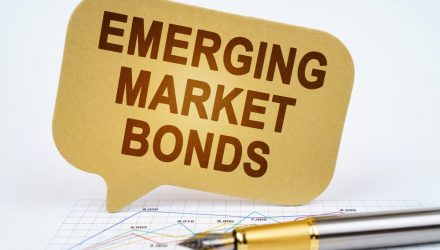Emerging markets debt proved sturdy in 2023. And more of the same could be on the way this year. That’s because fixed income investors are looking outside of the U.S. for elevated levels of income.
That could be good news for ETFs such as the BondBloxx JP Morgan USD Emerging Markets 1-10 Year Bond ETF (XEMD). Home to nearly $192 million in assets under management, it holds 308 bonds. Those bonds have maturities of up to but not in excess of 10 years.
Currently, fixed income investors are closely monitoring the Federal Reserve for clues about what’s next for Treasurys and other domestic bond segments. That’s important because the U.S. is by far the largest bond market in the world. But that doesn’t mean it’s time to ignore debt issued by developing economies. Actually, the opposite is true. And that indicates XEMD is a credible consideration among bond ETFs for 2024.
Examining Emerging Markets Bond ETF XEMD
XEMD, which turns two years old in June, is a play on interest rates in its own. As widely noted over the past few years, the Fed was late to hiking rates in the U.S. to ward off inflation. Broadly speaking, many emerging markets central banks were more proactive in raising borrowing costs in 2021, which sets the stage for more rate cuts this year.
Add to that, issuance of emerging markets debt is currently low. A dearth of supply could be a boon for existing bonds, included XEMD holdings.
“Meanwhile, technicals have emerged as a growing tailwind for the emerging-market debt sector. Issuance has been well below historical averages for two years running, and corporate net issuance has trended into negative territory. At the same time, the sector has seen major outflows, with 2022 and 2023 suffering the two largest annual outflows on record,” according to AllianceBernstein.
At the geographic level, XEMD offers some advantages, including one that’s sort of addition by subtraction. The ETF allocates just 3.73% of its weight to Chinese debt, which is potentially advantageous at a time when global fixed income investors are still concerned about the state of China’s real estate market. XEMD’s lack of China exposure could also be beneficial, as that country is widely viewed as the thorn in the side of EM debt.
“Nonetheless, we foresee a constructive environment for emerging-market bonds in 2024, provided investors stay selective. Emerging-market bonds represent an enormous asset class with considerable diversity. As always, it will be important for investors to carefully pick their spots and judiciously allocate assets,” concluded Alliance Bernstein.
For more news, information, and analysis, visit the Institutional Income Strategies Channel.

